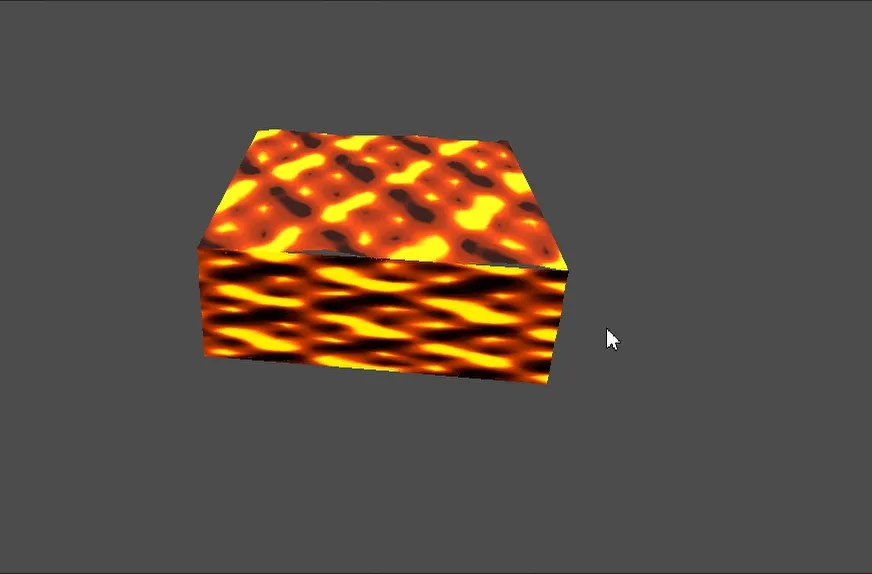Lava Shader

This shader, used in the Fire Pool Hazard, simulates lava and heat distortion. This shader is applied to a MeshInstance3D with a BoxMesh to create a glowing box of lava.
Effects
Section titled “Effects”- Lava Animation: Uses layered, scrolling noise textures to create an animated lava effect.
- Heat Distortion: Distorts the surface UVs with animated noise, simulating heat shimmer.
- Color Blending: Blends between cool, mid, and hot colors based on noise, creating a lava gradient.
- Emission: Boosts emission based on the ‘hotness’ of each pixel, making the lava appear to glow.
- Bubbling: The surface geometry is displaced in the vertex shader to create a bubbling effect.
Shader Code
Section titled “Shader Code”shader_type spatial;
uniform sampler2D noise_texture : source_color, filter_linear_mipmap, repeat_enable;
// Colorsuniform vec4 hot_color : source_color = vec4(1.0, 0.5, 0.0, 1.0);uniform vec4 mid_color : source_color = vec4(0.7, 0.2, 0.0, 1.0);uniform vec4 cool_color : source_color = vec4(0.2, 0.05, 0.0, 1.0);
// Animation Noiseuniform float master_time_scale = 1.0;uniform float noise_scale_primary = 2.5;uniform float noise_scale_secondary = 5.0;uniform float flow_speed_primary = 0.06;uniform float flow_speed_secondary = 0.035;
// Surface Distortionuniform float distortion_scale = 4.0;uniform float distortion_speed = 0.04;uniform float distortion_strength = 0.02;
// Emissionuniform float emission_boost = 4.0;
// Color Transition Thresholdsuniform float cool_thresh = 0.35;uniform float mid_thresh = 0.60;
// Bubbling (vertex displacement)uniform float bubble_strength = 0.1; // How much the surface "bubbles"uniform float bubble_scale = 4.0; // Scale of the bubbling patternuniform float bubble_speed = 0.3; // Speed of bubbling
void vertex() { float t = TIME * master_time_scale * bubble_speed; // Use UV for 2D noise vec2 bubble_uv = UV * bubble_scale + vec2(t, -t * 0.5); float bubble = texture(noise_texture, bubble_uv).r; // Center and shape the bubble effect bubble = (bubble - 0.5) * 2.0; // Animate with a little sine for extra "popping" bubble *= 0.7 + 0.3 * sin(TIME * 2.0 + VERTEX.x * 3.0 + VERTEX.y * 2.0); // Displace along normal VERTEX += NORMAL * bubble * bubble_strength;}
void fragment() { float current_time = TIME * master_time_scale;
// Create two differently scrolling UVs for sampling distortion noise vec2 dist_uv_scroll_base = UV * distortion_scale; vec2 dist_uv1 = dist_uv_scroll_base + vec2(current_time * distortion_speed, current_time * distortion_speed * 0.7); vec2 dist_uv2 = dist_uv_scroll_base + vec2(-current_time * distortion_speed * 0.5, current_time * distortion_speed * 1.2);
float d_x = texture(noise_texture, dist_uv1).r; float d_y = texture(noise_texture, dist_uv2).r;
vec2 uv_offset_for_distortion = vec2(d_x - 0.5, d_y - 0.5) * distortion_strength; vec2 distorted_base_uv = UV + uv_offset_for_distortion;
vec2 uv_flow1 = distorted_base_uv * noise_scale_primary; uv_flow1.x += current_time * flow_speed_primary; uv_flow1.y += current_time * flow_speed_primary * 0.6; float noise_val1 = texture(noise_texture, uv_flow1).r;
vec2 uv_flow2 = distorted_base_uv * noise_scale_secondary; uv_flow2.x -= current_time * flow_speed_secondary * 0.7; uv_flow2.y += current_time * flow_speed_secondary; float noise_val2 = texture(noise_texture, uv_flow2).r;
float combined_noise = (noise_val1 + noise_val2) * 0.5;
vec3 final_albedo_color; float t_cool_to_mid = smoothstep(cool_thresh - 0.05, cool_thresh + 0.05, combined_noise); final_albedo_color = mix(cool_color.rgb, mid_color.rgb, t_cool_to_mid);
float t_mid_to_hot = smoothstep(mid_thresh - 0.05, mid_thresh + 0.05, combined_noise); final_albedo_color = mix(final_albedo_color, hot_color.rgb, t_mid_to_hot);
ALBEDO = final_albedo_color;
float hotness_for_emission = smoothstep(cool_thresh, mid_thresh + 0.1, combined_noise); EMISSION = final_albedo_color * pow(hotness_for_emission, 2.0) * emission_boost;}Shader Parameters
Section titled “Shader Parameters”noise_texture: Noise texture used for animation, distortion, and bubbling.hot_color,mid_color,cool_color: Colors for the hottest, mid, and coolest parts of the fire.master_time_scale: Scales all time-based animation.noise_scale_primary,noise_scale_secondary: Scales for the two main noise layers.flow_speed_primary,flow_speed_secondary: Animation speeds for the two noise flows.distortion_scale,distortion_speed,distortion_strength: Control the scale, speed, and strength of the heat distortion effect.emission_boost: Multiplier for the emission (glow) intensity.cool_thresh,mid_thresh: Thresholds for color transitions between cool, mid, and hot.bubble_strength,bubble_scale,bubble_speed: Control the strength, scale, and speed of the bubbling effect.
Shader Logic
Section titled “Shader Logic”- Vertex Shader:
- Displaces vertices along their normals using noise, creating a bubbling surface.
- The bubbling is modulated by a sine wave for extra liveliness.
- Fragment Shader:
- Distorts UVs with noise to simulate heat shimmer.
- Samples two scrolling noise layers for lava animation.
- Blends between cool, mid, and hot colors based on combined noise.
- Sets emission based on the ‘hotness’ of each pixel, making the lava glow more in hotter regions.